#comic book guide
Text
I'm putting together various storyline chronologies for my own reference, and just finished the Batfamily one. It's not the most elegant, but it might help anyone who wants to know the order. Alt text included.

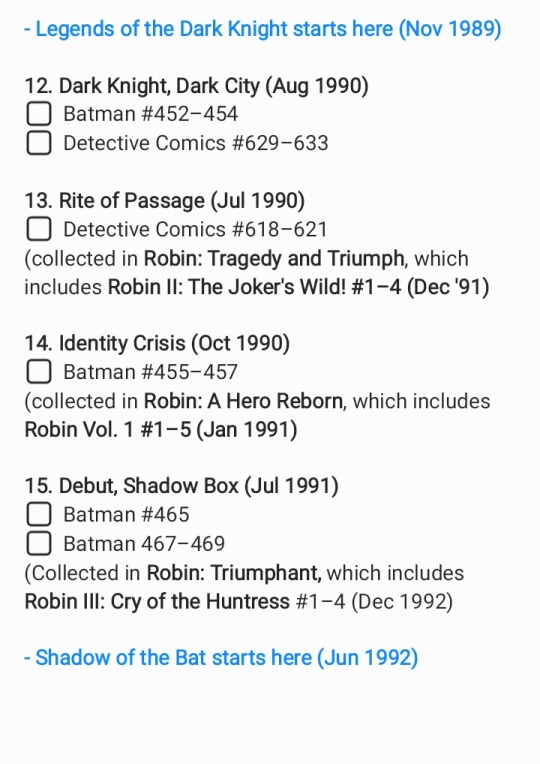


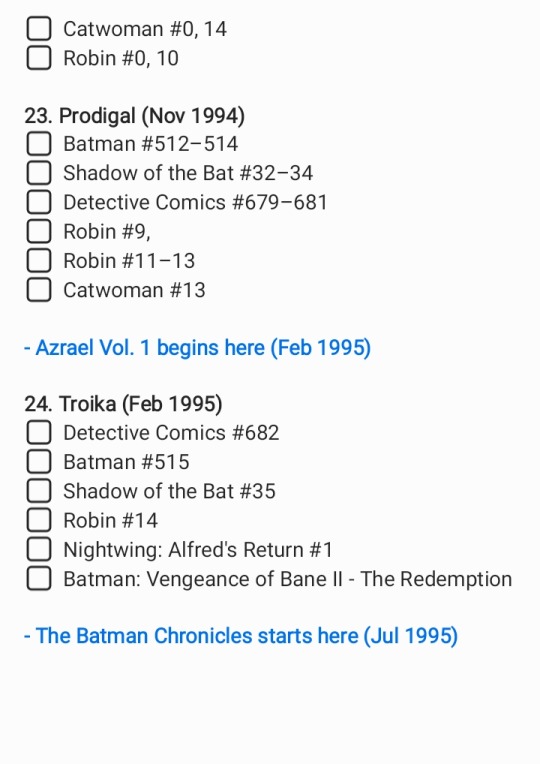

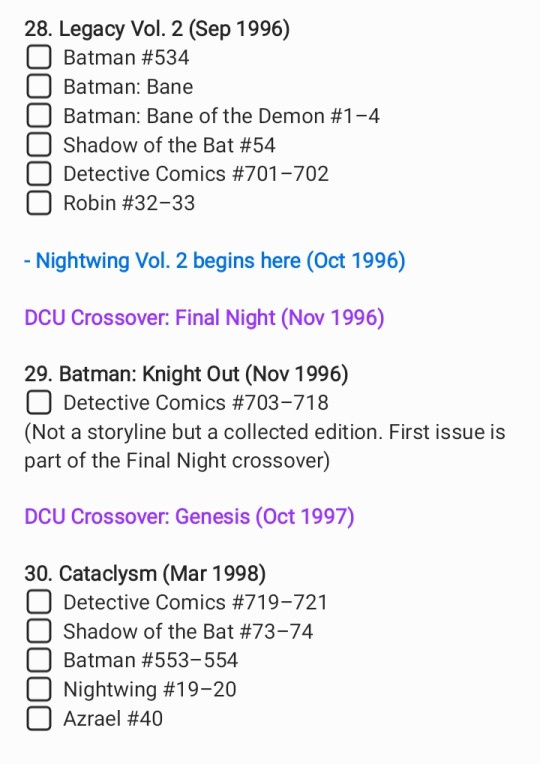



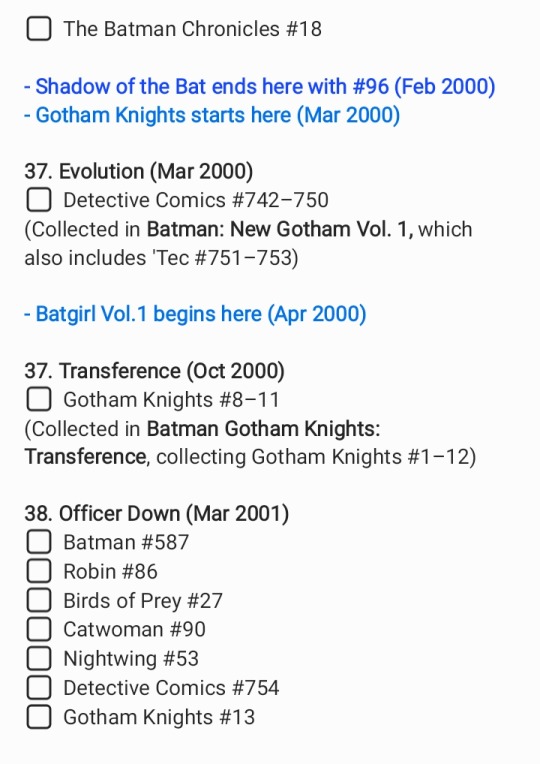
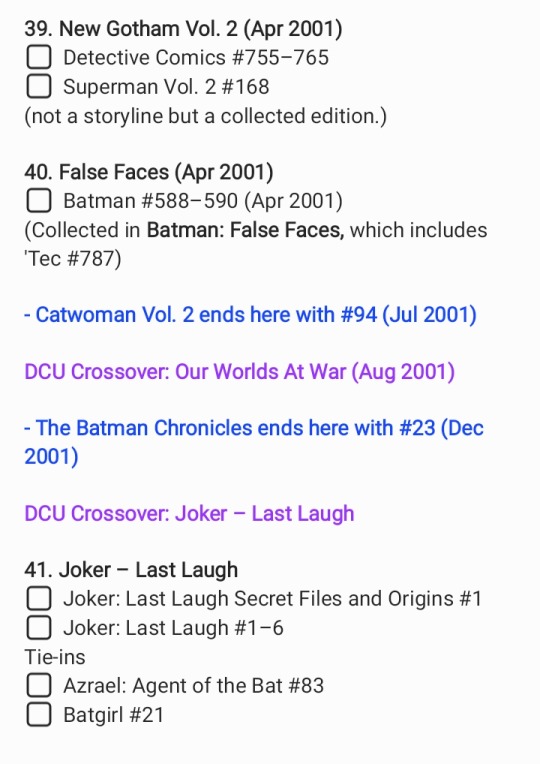









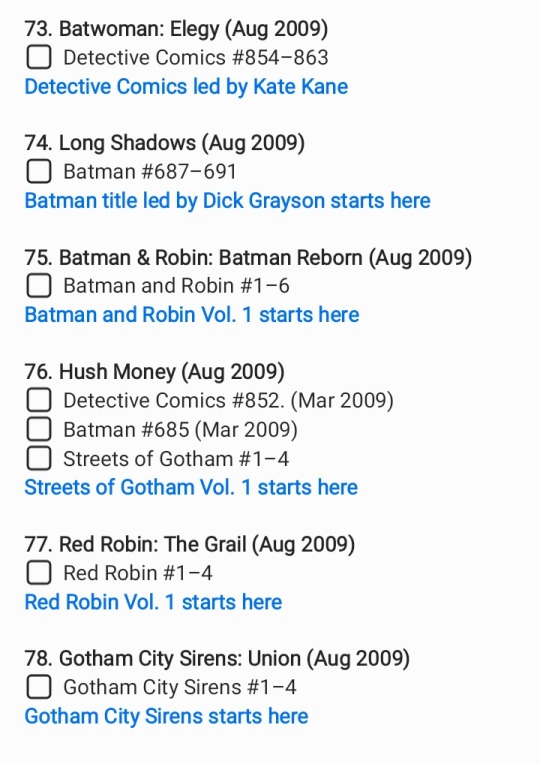
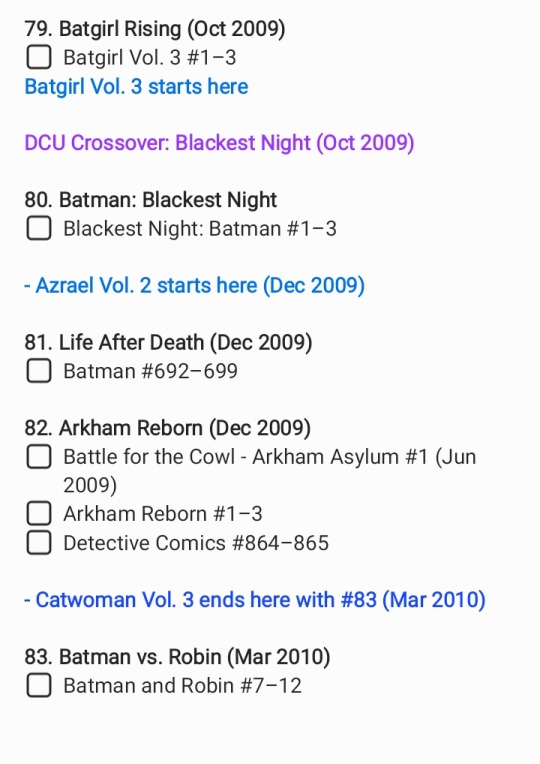

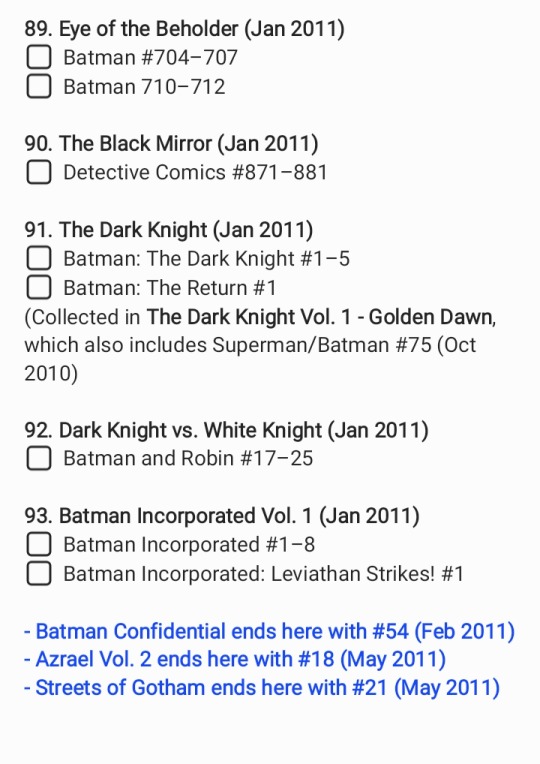


See this reblog for further info about No Man's Land.
The Complete Knightfall
Not included: character backstories like Long Halloween, the Year One series or Red Hood: Lost Days. Will do a separate post for them.
See also:
Complete list of Batman Vol. 1 issues (1986–2011)
Complete list of pre-reboot Detective Comics (1986–2011) issues
Complete list of Shadow of the Bat Vol. 1 (1992–2000) issues
Legends of the Dark Knight Vol. 1 (1989–2006) collections
Complete list of Legends of the Dark Knight Vol. 1 issues
Complete list of Gotham Knights Vol. 1 (2000–2006)
Complete List of Batman Mini-series (1986–2011)
Complete List of Streets of Gotham Vol. 1 issues (2009–2011)

Complete List of Batman Elseworlds stories
Complete List of The Batman Chronicles Vol. 1 (1995–2001)

#batman#batman comics#comic book guide#DCU#DC comics#reading guide#comics history#batfamily#reference#comics chronology#bruce wayne#dick grayson#Pre52#preboot#jason todd#tim drake#damian wayne#stephanie brown#cassandra cain#barbara gordon#birds of prey#robin#nightwing#batgirl#red robin#red hood#oracle#spoiler#black bat#spite waffle
155 notes
·
View notes
Text
A “Kinda” Simple Guide On How To Read The X-Men








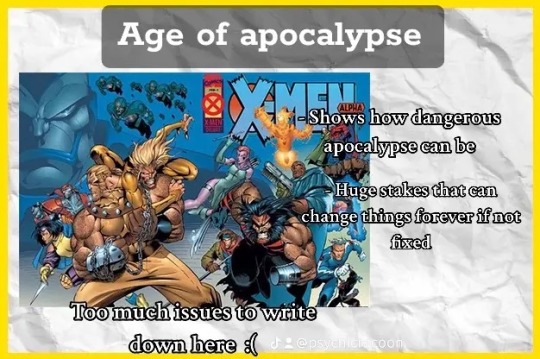

This is from my TikTok but since that whole app might get put down like a dog I’m just throwing all my comic reading guides here. That’s why it looks like this lol
#comic books#marvel#marvel comics#x men#wolverine#scott summers#jean grey#nightcrawler#magneto#professor x#storm#colossus#apocalypse#kitty pryde#reading guide
307 notes
·
View notes
Text
A guide for reading The Sandman: Part 2
So... You have read the full Sandman series. You went from issue 1 to issue 75. From beginning to end. You had all the ten volumes. Congrats!
But I am sorry to tell you, you don’t actually have the full Sandman story. You see, Neil Gaiman wrote and created much more than just the numbered issues. He created a lot of side-stories, side volumes and “specials” whose presence are either exciting and thrilling additions to the Sandman mythos, or key elements needed to understand the plots and happenings of the main story. Don’t get me wrong, if you just read the numbered issues you’ll get the full story without problem. But you’ll still be missing the second part of the complete Sandman world. The “specials”. In French we have a clever word for that: the “hors-séries” (literally means “outside of the series”, it is still part of the world but not inside the numbered series).
Given there is a lot of those specials, I’ll classify them by “publishing order”. You’ll get what I mean.
I) The Sandman library
After being released as a series of numbered issues, The Sandman was collected in the ten volumes I described previously. Out of these volumes, one included actually more than just the numbered issues: volume 6, “Fables and Reflections”, added two Sandman specials.
# “Fear of Falling” was originally a story published as its own for a one-shot issue called “Vertigo Preview” whose function, as the name indicates, was to serve as a big preview for most of the Vertigo titles. As a result, the issue contains previews and half-stories for most of the Vertigo titles: Hellblazer, Doom Patrol, Swamp Thing, Shade the Changing Man... It also includes previews for two specials I will talk about later, Death: The High Cost of Living, and Sandman Mystery Theater. But these are all just previews. There is only one full, complete story, which is precisely “Fear of Falling”, conceived originally as a way to give a taste of Sandman to newcomers.
# The Song of Orpheus. Originally it was published as its own as “The Sandman Special”, but it was included into this first collection of Sandman issues due to how important the story is : for you see, it gives the complete backstory of Orpheus, who is an important character in The Sandman. And while just a retelling of the myth, it is still very precious to understand the full impact of the character.
II) The 30th anniversary edition
After publishing those ten volumes, DC celebrated the 30th birthday of The Sandman by reprinting them... WITH FOUR BONUS VOLUMES!!!
# The first added Volume, Volume 11, is called “Endless Nights”. This specific volume was originally published as its own under the name “The Sandman: Endless Nights”. Published in 2003, so long after the end of The Sandman, it is a set of seven stories, each centered around a different Endless sibling, and their whole purpose is just to further expand the world of The Sandman, and flesh out more the other Endlesses by showing stories from THEIR perspectives. It is technically an “anthology volume / expansion volume” that is not needed to understand the full story, but makes a nice addition to better understand the scope of the world and the working of the Endless. It does however contains spoilers for “Brief Lives” and further, so... it is at its right place as “Volume 11″.
# The second added Volume is NOT called Volume 12 as you would expect. It is rather called... Volume ∞. Of its full name: The Sandman: Overture. This volume was originally a six-part limited series created by Neil Gaiman in 2013 (so LONG after the end of The Sandman, and well after Endless Nights). This is the latest and final work by Neil Gaiman in The Sandman world so far, and it was designed as a sort of “grand finale”. Some people will tell you “It is the first work in chronological order so you should begin here”. DO NOT DARE! THESE PEOPLE ARE LYING TO YOU! Beginning here is the WORST idea you can have. If you want to begin The Sandman, you begin at issue 1, like Neil Gaiman himself.
For you see, “Overture” is a dual story, two series of events tied together that happen, one after the end of The Sandman (so after issue 75) and the other before the beginning of the Sandman (so before issue 1). Overture is both the prologue to The Sandman AND its epilogue. Beginning and end, alpha and omega... Hence the ∞ symbol. It is without a doubt the best way to end the series.
# The two other volumes are both unumbered and called “The Sandman: The Dream Hunters”. And they both tell the same story. So why are there two volumes? Because one is an illustrated novel, and the other is a full comic book issue.
Originally, Neil Gaiman published “The Dream Hunters” as a novel/novella in 1999 (so three years after the end of The Sandman, but before the publication of Endless Nights). It was a fictional story he invented, based upon and inspired by Japanese folklore and Japanese fairytales. Illustrated by Yoshitaka Amano, it takes place in The Sandman world, though it is not part of the main plot and you can actually read the story with no prior knowledge of The Sandman. It became so popular that for the 20th anniversary of The Sandman, in 2008-2009, the novel was adapted into a comic book, a four part mini-series that became its own Sandman volume.
Fun fact: when Neil Gaiman published the story, he wrote in it a fake “origin” claiming he was just adaptating a part of Ozaki’s famous “Old Japanese Fairy Tales”. It was a lie, as Neil Gaiman had entirely invented the story, but it fooled a lot of people who sincerely believed it was some sort of secret or missing story from Ozaki’s book. (He notably had to clear up the matter in “Endless Nights”).
III) The Absolute Sandman
Now you probably think: wow... this is a lot. But I got everything, right? NO YOU FOOL! DC, seeing the enormous success of The Sandman, decided to reprint a new edition of the compilation: The Absolute Sandman, even bigger than the 30th Anniversary edition. Not ten or twelve volumes, but rather six (five numbered volumes plus Overture), containing everything I talked about above (The Sandman Special, Endless Nights, Overture, The Dream Hunters...). Plus more specials not yet included in compilations! Resulting in five volumes + The Absolute Sandman: Overture + one special volume called “The Absolute Death”.
# The Vertigo: Winter’s Edge comics. Vertigo’s Winter Edge was a limited series published from 1998 to 2000 celebrating, every winter, the different lines and series of the Vertigo imprint with special stories. It ran for three issues, and each of them has one story created by Neil Gaiman tied with or part of The Sandman universe. One will maybe ring familiar to the viewers of the show: “A Winter’s Tale”, published in the second issue (1999). This story is actually a description of Death’s backstory, answering many questions about her “life” before the events of The Sandman (and also revealing answers to some questions raised in “Endless Nights”, even though it was published AFTER this story). Parts of it were adapted in the first season of The Sandman tv show.
The other two stories of Winter’s Edge are “The Flowers of Romance”, from Winter Edge 1998 and “How They Met Themselves” from Winter Edge 2000. These stories are fascinating because they actually depict Desire as the protagonist and “hero”. You see, as Gaiman points out, Desire plays an antagonistic role in The Sandman merely because Dream is the protagonist. But here he decided, why not show the reverse, the world where Desire is the protagonist, the “nice” side of Desire: the result are those two stories.
[ The Vertigo: Winter’s Edge issues also contain stories belonging to “The Dreaming”, a spin-off of The Sandman, but given Neil Gaiman was not involved in those I’ll keep it for a later post]
# “The Castle”. This story was originally published in “Vertigo Jam”, which is basically quite similar to “Vertigo Preview” and “Vertigo: Winter Edge”, just a one-shot issue that was an anthology of various stories, each taking place in a different series of the Vertigo imprint.
# The Death mini-series. In 1993, the same year as The Dream Hunters, Neil Gaiman wrote a mini-series with Death as the main protagonist. It was called “Death: The High Cost of Living”. This Death-centered story had three years later a “twin mini-series”: “Death: The Time of Your Life” in 1996 (coupled with the return of Hazel and Foxglove from “A Game of You”). These two were then gathered here as a duo in a special volume of The Absolute Sandman called “The Absolute Death” and centered around, you guessed it, lot of Death material.
# The “educational” Sandman. This “Absolute Death” volume also contains two “PSA material” or “Very Special Episode” issues. One is a story centered around Destruction and called “The Wheel”, which was originally part of a very special DC volume: 9-11: The world’s finest comic book writers and artists tell stories to remember. You can safely guess what the story is about. The second story is not actually a story, but a Death-centered AIDs pamphlet called “Death Talks About Life”. It had been originally coupled with several other issues of DC comics: it was found in the issue 32 of “Shade the Changing Man” (the 1990 series) ; it was also found in the 62nd issue of Hellblazer, and finally in the 46th issue of The Sandman. But it also existed as its own, unique pamphlet distributed in schools to raise awareness of HIV and AIDS.
# Sandman Midnight Theater. The last of the specials created by Neil Gaiman, and one of the last pieces to The Sandman puzzle. Long story short... There were several “Sandman” super-heroes in the DC Universe. In fact, Neil Gaiman began “The Sandman” as his own personal take on the several Sandmen super-heroes of the DC world. The very first of those Sandmen was Wesley Dodds, a Batman-like vigilante of the 30s that was part of the Golden Age of comics. In fact, Wesley Dodds himself appears in the first issue of Neil Gaiman’s The Sandman, and is part of The Sandman universe. After the end of Neil Gaiman’s series, the popularity of Wesley Dodds increased again and so in 1993 was launched a “reboot” of the original adventures of the Sandman, a new series around Dodds called “Sandman Mystery Theater”.
Sandman Midnight Theater is precisely a crossover issue between Sandman Mystery Theater and Neil Gaiman’s The Sandman.
# “The Last Sandman Story”. This is actually not a comic book story. It was a prose story, semi-autobiographical, written by Neil Gaiman for “Dustcovers: The Collected Sandman Covers”, which as the name says compiled all of the covers of Dave McKean (plus I think he also illustrated this specific story?). It a sort of confession story, a text by Neil Gaiman about real-life and his relationship with The Sandman series and the character of Dream. And, as the name says, it was written to be released at the conclusion of the main series, post-issue 75.
There you go! These are all the specials created by Neil Gaiman and that are part of the canon and official Sandman series. Of course there is more bonus to talk about: Neil Gaiman gave a lot of interviews about The Sandman in which he reveals all sorts of details and secrets, and they can be found across various books - the Sandman Companion, the Absolute Sandman editions, the Omnibus Sandman editions, there’s plenty of places to look at.
So... is it done? Is it over?
Yes and no. With this, you have covered everything in The Sandman world made by Neil Gaiman. So this is basically all the “canon”.
But The Sandman created a lot of spin-offs and side-stories that were not created or that are not linked to Neil Gaiman... as with many comic book worlds, it expanded beyond its original creator. So maybe I will cover all the non-Neil Gaiman Sandman stories in a third part. Maybe. If I have time.
#sandman#the sandman#comic books#comic book#comics#reading guide#neil gaiman#specials#dream of the endless#death of the endless#desire of the endless#destruction of the endless
5K notes
·
View notes
Text



if no one else got me, I know the Rick and Morty Character Guide (2020) got me
#rick and morty#rick and morty character guide#beth smith#beth sanchez#rick sanchez#it's a little blurry but still readable !! and like ! <3#i love whenever there are GOOD takes#'Beth Smith holds near-mythical signifcance among the range of Sanchez theorists'#'It is also possible that the man simply loves her#but does not possess the ability to express how'#I'm crying in the club rn 🥺🥺🥺❤️❤️❤️#season 7 has been a Beth drought so I have to resort to books and comics to get what I need
123 notes
·
View notes
Text
#books#bookshelf#bookblr#reading#polls#library#somewhere around 700 with comics cookbooks and field guides included
396 notes
·
View notes
Text

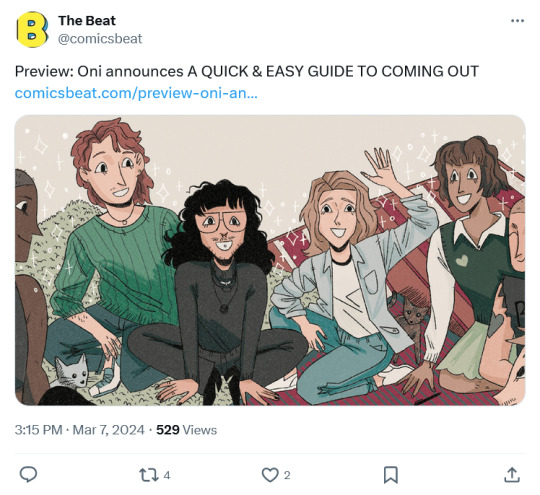
look what just got announced!! this is my debut into the comics world, unless you count some equally amazing anthologies, and i've been working on it for ages!! i'm so happy and excited and aaaaa!!! this is the book i've worked so hard on!!! and its real!!! aaaaa!!!!
49 notes
·
View notes
Text
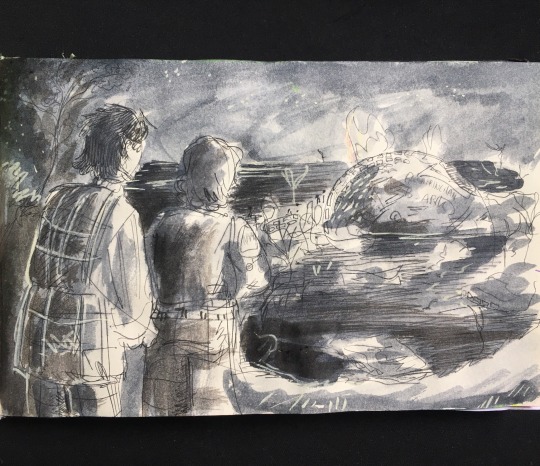


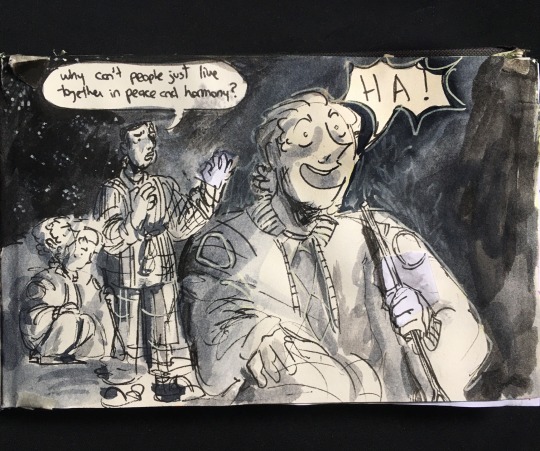





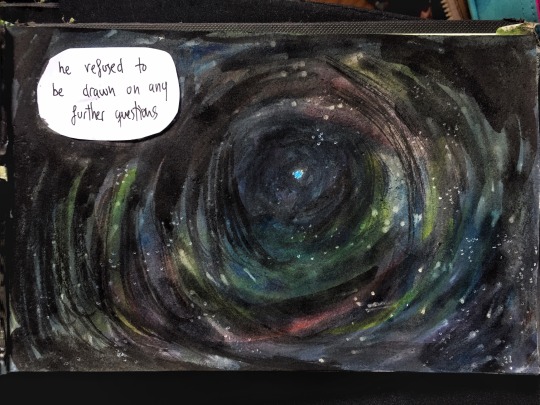
#there is something about the way Douglas Adams words his sentences#that makes me want to draw them#ford prefect#arthur dent#h2g2#hitchiker's guide to the galaxy#forthur#h2g2 fanart#comic#the restaurant at the end of the universe#is my favorite book I think#closely followed by so long and thanks for all the fish#fanart#lara art tag
161 notes
·
View notes
Text
Who is.... Mia Dearden | Speedy? - A Reading Guide
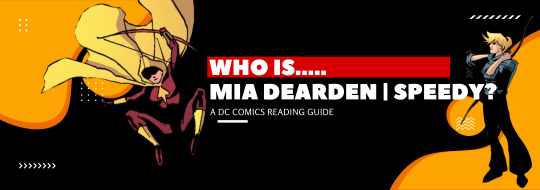
Mia Dearden (Speedy) is the adopted daughter of Oliver Queen (Green Arrow)- she is introduced in the first arc Green Arrow (2001). Mia's backstory is the definition of tragedy, she's a CSA survivor, a runaway, a human trafficking survivor, and as a result of her childhood trauma has been diagnosed as HIV+. Mia is a loudmouth who will backtalk villains, family members, and anyone she encounters. She fought Oliver Queen for the chance to become Speedy, and took up the mantle of Speedy because her life means something to her and what she wants to do with it is help others.
Reading list under the cut!
The following is a list of Mia's appearances barring those in the N52. As always if multiple issues from a run are listed, only the first issue will be linked as the assumption is that you can navigate to the other issues yourself.
Green Arrow (2001) #2-6, 8-11, 13-15, 22, 27, 29-35, 37-43
Green Lantern Rebirth #1
Green Arrow (2001) #44-47
Teen Titans Vol. 3 #21
Green Arrow (2001) #48
Teen Titans Vol. 3 #22
Countdown to Infinite Crisis #11
Green Arrow (2001) #49
Teen Titans Vol. 3 #23
Green Arrow (2001) #50
Teen Titans Vol. 3 #24-25
Green Arrow (2001) #52
Outsiders Vol. 3 #25
Teen Titans Vol. 3 #26
Gotham Central #34
Green Arrow (2001) #55-56
Teen Titans Vol. 3 #30
Green Arrow (2001) #57
Teen Titans Vol. 3 #31-32
Infinite Crisis #4
Robin Vol. 2 #146
Battle for Blüdhaven #1 (I couldn't find a link for this one T.T)
Infinite Crisis #5
Teen Titans Vol. 3 Annual #1
Robin Vol. 2 #147
Teen Titans Vol. 3 #34
Infinite Crisis #7
52 #10
Green Arrow (2001) #64
Teen Titans Vol. 3 #38
Green Arrow (2001) #65-75
Black Canary Vol. 3 #2-4
Green Arrow/Black Canary Wedding Special
Countdown to Final Crisis
Green Arrow/Black Canary #1-9
Birds of Prey Vol. 1 #119
Green Arrow/Black Canary #10-14
Final Crisis #6
Birds of Prey Vol. 1 #124
Green Arrow/Black Canary #15
Teen Titans Vol. 3 #66
Green Arrow/Black Canary #24-26
Titans Vol. 2 #19
Green Arrow/Black Canary #27-29
Cry for Justice #7
Green Arrow/Black Canary #30
Rise of Arsenal #1
Green Arrow/Black Canary #31
Rise of Arsenal #2
Green Arrow/Black Canary #32
Teen Titans Vol. 3 #99-100
#mia dearden#speedy#arrowfam#reading lists#reading list#reading guide#reading guides#comic books#comics#dc comics#dc
359 notes
·
View notes
Text
Deena Mohamed’s ‘Shubiek Lubiek’

Shubeik Lubeik, a trilogy of graphic novels by Deena Mohamed, took the Arab comics world by storm, winning Best Graphic Novel and Grand Prize at the Cairo Comix Festival; today, Pantheon Books releases a gorgeous hardcover omnibus English translation:
https://www.penguinrandomhouse.com/books/606934/shubeik-lubeik-by-deena-mohamed/
The world of Shubeik Lubeik is an intricate alternate history in which wishes are real, and must be refined from a kind of raw wish-stuff that has to be dug out of the earth.
Naturally, this has been an important element of geopolitics and colonization, especially since the wish-stuff is concentrated in the global south, particularly Egypt, the setting for our tale.
Though the underlying wish mechanism is metaphysical, Mohamed plays out her worldbuilding in a very science fictional way, constructing an intricate — and skillfully deployed — set of social consequences for a world where wishes are a fact of life.
Indeed, it’s this science fictional trick of “in-clueing” (to use Jo Walton’s excellent critical term) that makes Shubiek Lubeik such a cracking, cross-cultural read:
https://www.tor.com/2010/01/18/sf-reading-protocols/
For though the three stories that make up the trilogy are intensely culturally situated in modern Egypt, they play out as universal, intricate human ethical dilemmas. Mohamed delivers the realistic — but unfamiliar to westerners — depiction of contemporary Egyptian life with the same smart, deft technique that she uses to paint in the rules of a world where wishes are real.
The framing device for the trilogy is the tale of three “first class” wishes: these are the most powerful wishes that civilians are allowed to use, the kind of thing you might use to cure cancer or reverse a crop-failure.
These first-class wishes are the near-exclusive purview of the rich and powerful and their use is tightly monitored and licensed. However, three of these wishes, of Italian origin, are, improbably, in the inventory of Shokry, a poor, pious kiosk owner in central Cairo.
Despite knock-down prices, no one wants to buy Shokry’s wishes. Potential customers are put off by his desperate, hand-lettered sign advertising the wishes, combined with the implausibility of first-class wishes being offered for sale in a humble koisk.
But one of Shokry’s regulars, a fiery old lady who buys her cigarettes from him each day, convinces him to let her nephew design a slick poster advertising the wishes, and the tale begins in earnest.
Every story of a wish is both a puzzle — how would you construct a wish so that it couldn’t possibly backfire — and an ethical conundrum. That is what makes wish stories so delicious to read, whether it’s Sheherezade’s tales or O. Henry.
The engine of wish-fulfillment is a powerful one, capable of hauling behind it almost any kind of tale. Mohamed’s three-act play blends class- and sectarian divides, gender relations, depression and resilience, and kindness and regret.
The first volume, Aziza, is about corruption, using a parable about elite wish-hoarding to tell a wrenching story about loss, love, hope and resilience. It’s a gorgeous, deeply romantic love story, and because it’s a wish story, there’s a devilish twist.
The second volume, Nour, is about depression, privilege, coping, and gender (and, like Aziza, it’s ultimately about resilience, too). There’s some delicious worldbuilding here, and Nour herself is a great character, whose depression is mapped in a series of comedy charts worthy of Randall Munroe.
The conclusion, Shorky, opens the world up, showing us how wishes interact with theology, colonialism, the antiquities trade, and sectarian Egyptian politics. All three stories have wish-style surprises, but the surprises in this one are jaw-dropping. And while all the stories have a lot of broad comedy and great characterization, this one introduces a sprawling cast that is choreographed with absolute mastery.
It’s easy to see why this book did so well in the Arab world. It’s incredibly exciting to see it in English. Many of us have experienced Japanese comics, of course, and if you follow the brilliant publishing program of First Second, you’ve gotten some great French and Spanish comics. But this is the first graphic novel from the Arab world that I’ve had the pleasure of reading. It won’t be the last.
[Image ID: The cover for the Pantheon English translation of Deena Mohamed's 'Shubeik Lubeik.']
#comics#arabic#books#egypt#colonialism#fantasy#science fiction#worldbuilding#allegory#gift guide#reviews
190 notes
·
View notes
Text
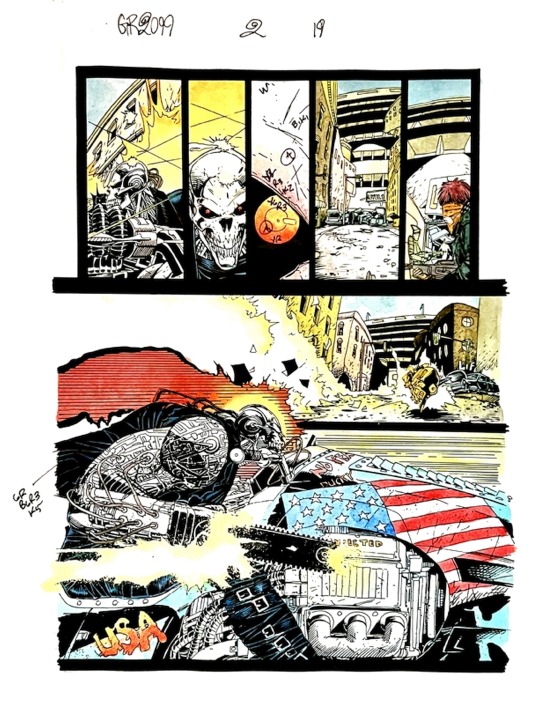
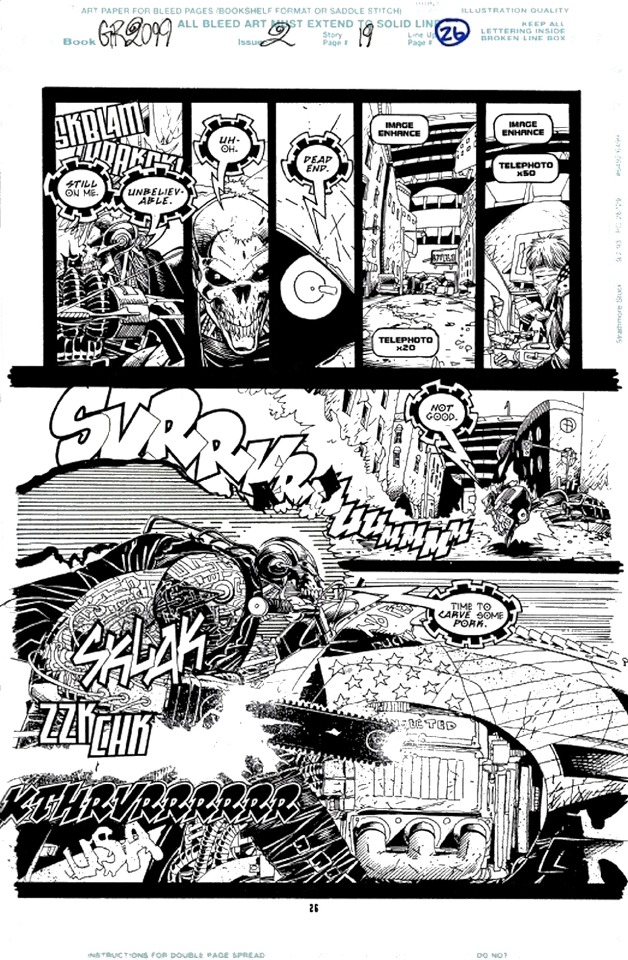
Ghost Rider 2099 2 pg19 by Chris Bachalo
51 notes
·
View notes
Text

Shazam! #13 (DC, July 2024) Artist Spotlight variant cover by José Luis García-López
#shazam!#jose luis garcia lopez#comics#comic books#variant covers#dc#dc comics#dc comics style guide#shazam#comic covers#cover art
13 notes
·
View notes
Text
The Complete Nightwing (Pre-52)

Google Drive link and Complete List of Nightwing Issues and Extras under the cut.
(Please let me know if you want me to upload anything else)
Link to Google Drive
Other references: Post-Crisis Dick Grayson timeline by @bitimdrake






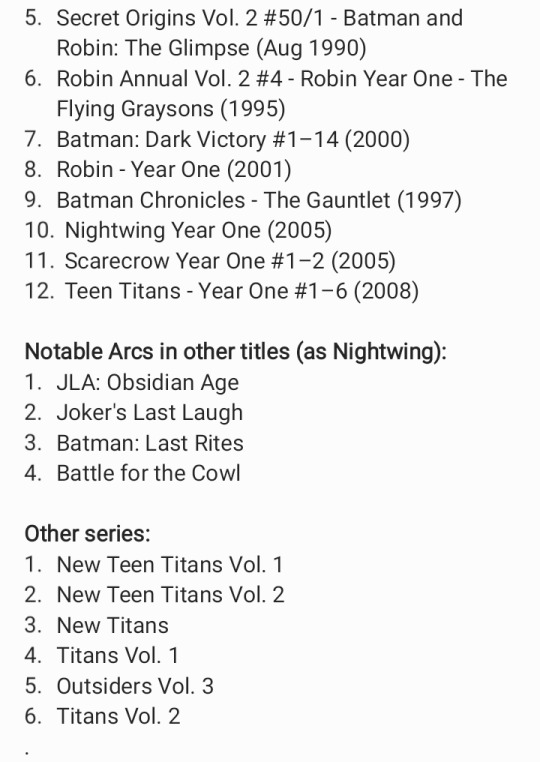
Other Google Drive Links:
New Teen Titans
Titans Vol. 1
Outsiders Vol. 3
Titans Vol. 2
See also (lists only, drive not yet uploaded):
Complete Chronological List of Pre-52 Batman storylines and collected editions
Complete list of Batman Vol. 1 issues (1986–2011)
Complete list of Pre-52 Detective Comics (1986–2011)
Complete list of Shadow of the Bat Vol. 1 (1992–2000)
Complete list of Legends of the Dark Knight Vol. 1 issues & issue collections
Complete list of Gotham Knights Vol. 1 (2000–2006)
Complete list of Batman Mini-series (1986–2011)
Complete List of Batman One-Shots
Complete list of Streets of Gotham Vol. 1 issues (2009–2011)
Complete List of The Batman Chronicles Vol. 1 (1995–2001)
Complete List of Batman Elseworlds stories
Complete List of Pre-52 Batgirl issues
#batman#batman comics#comic book guide#DCU#DC comics#reading guide#comics history#batfamily#reference#pre-reboot#pre52#preboot#comics chronology#bruce wayne#dick grayson#nightwing#alfred pennyworth#tim drake#robin#barbara gordon#oracle#helena bertinelli#huntress#spite waffle
55 notes
·
View notes
Text
On the topic of Hal Jordan being maybe a bit better than anyone gives him credit for…
[I’m kidding ofc, we all know he’s a great guy, but bear with me for the sake of this post hahaha]
⚠️ Spoilers for Green Lantern #5 ⚠️
I get it, y’all, I really do. Hal can be pushy when it comes to love. And pretty undeserving of the love he pushes for because I mean how good is a guy that keeps professing his love to the same girl only to ditch her for long and unspecified stretches of time. Like of course, Carol keeps moving on, Hal, there’s absolutely no reason why she should wait around for some guy that loves her, but still leaves her! But hear me out…
Maybe Hal being pushy doesn’t actually change the fact that he’s a good guy. Maybe his pushiness is sincere. And maybe, just maybe, he’s a big enough person to set the whole “all is fair in love and war” thing aside to do what’s right and that’s what makes him so dang hard to resist.
So, this all stems from the latest issue of Green Lantern by Jeremy Adams and Xermánico which features Hal setting out to put a stop to Sinestro’s reign of terror across the earth. Hal’s first stop is Ferris Air as Sinestro has taken over all their unmanned drones to enact his plan. Carol catches Hal up on the situation and as he’s leaving to do his superheroics Carol hands him some nifty new communicators designed by her new fiance, Nate, y’know, the guy that Hal has been at one-sided odds with since the first issue of this new run. Hal, predictably, makes a snide little Hal-comment about Nate being smart and Carol, predictably, gives him no rope when she shortly replies that he’s “very” smart. I’ll always love these terse little exchanges between them.

Hal later runs into the problem of the last two drones being too far away from each other, and too close to their intended targets, for him to reach them in time. This leads to him coming up with the idea of putting his piloting skills, and indomitable will, to the test by simultaneously sending two constructs in opposite directions to catch the last two drones. Carol puts Nate on the line, and this is where my admiration for Hal, and Adams as a writer, grows considerably, as rather than getting another typical Hal remark we get a man on a mission.


Hal doesn’t care who’s guiding him in, he doesn’t care that he’s lost the love of his life (for no reason other than his own hubris) and that the one who has earned her love is now talking to him one-on-one. Rather than taking the easy drama route of giving Hal yet another opportunity to undercut his latest rival, Adams instead opts for the much more in-character route of having Hal just be the hero that he is. Hal’s only care is that there are people in trouble and Nate is the only person who can help him. And man, do they make a great team.

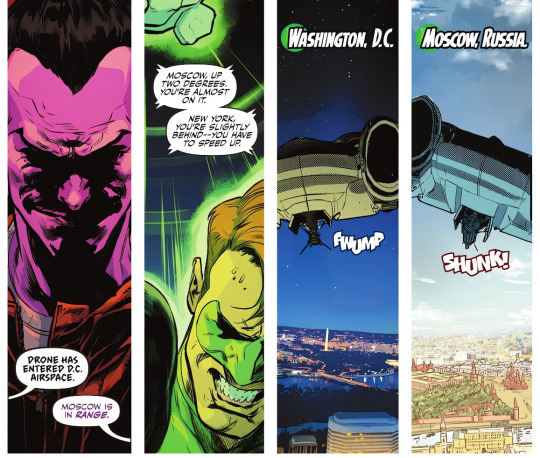

And this is a fact that neither gets nor needs any particular highlighting from the story itself. No remarks about Nate being the one to guide Hal in are made. Nothing is said about how well Hal followed directions from his rival-in-love. And that’s kinda my favorite part of all of this, the conclusion that I’ve come to, that Hal is not in the least bit petty and is a wholly honorable person, is not a conclusion that the story busies itself with proving. It just is. Hal just is a hero. He just is a good guy. He just does the right thing because that’s the right thing to do and, man, does that make it hard to say no to him.
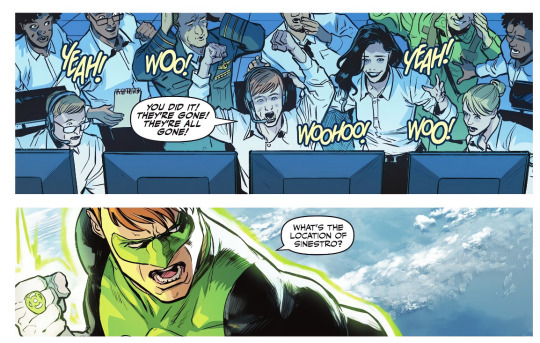
#Green Lantern#GL#Jeremy Adams#Xermánico#Hal Jordan#Paralax#The Spectre#Green Lantern Corps#GLC#Carol Ferris#Star Sapphire#DC Comics#Comic Books#Comics#Thoughts#Opinions#Real tags are done so now onto the secret thoughts tags#this is a silly essay that I wanted to write purely bcs I read way too far into Nate being the one to guide Hal#nothing in this holds any weight beyond my unending need to put too much significance into insignificant details#Adams writes Hal way too well for me to not write at least one essay about it tho#please don’t come after me over this I’m just trying to have fun lol#please feel free to validate my thoughts with your own similar musings tho#Hal and Carol belong together btw and I’m fully expecting Adams to show that in this run
35 notes
·
View notes
Text
A guide for reading The Sandman: Part 1
People will discover the television series and want to read “The Sandman”, the original comic books.
Some people are already reading “The Sandman” and are getting a bit confused about where to go with oh-so-many titles, extensions and expansions.
And some people already think they read all of the Sandman until they discover a new issue they never heard of.
Well this guide is here for you! A small guide to explain the reading order of The Sandman, what to expect and where to go!
Part 1 will be dedicated to the original Sandman series, aka the “main story”, the “main series”, the original numbered issues going from Sandman 1 to Sandman 75 ; the original series running from 1988 to 1996.
This series is divided into “volumes” (of course, those didn’t exist originally as the series was published issue after issue, the volumes were collected afterward - but each volume corresponds to an “arc”, a “step”, an “episode” in the wider story). The volumes in The Sandman actually alternate between volumes that contain a full story (basically “arc volumes”), a neat and clear story with a beginning and an end that together form the main story of Sandman ; and volumes that I would be tempted to call “expansion” volumes or “illustration” volumes - volumes that do not contain one overall story but rather a series of small stories, scenes, vignettes, “anthology” volumes whose role is to expand the world of the Sandman, and make the reader learn more about aspects or backgrounds of several characters, elements or details of the “arc stories”.
Volume 1: Preludes and Nocturnes (arc-volume)
Contains issues 1 to 8. Preludes and Nocturnes is the start of The Sandman series, and what corresponds to the first half of the first season of the TV show. It is the story of how Dream of the Endless was imprisoned by a human wizard, the damage this imprisonment caused, and Dream’s quest to find back his items of power: his pouch of sand, his helmet and his ruby. Preludes and Nocturnes is quite noticeable, in comparison with the rest of The Sandman, as being HEAVILY relient on the DC Comics universe, with a lot of references to the DC Universe, its super-heroes and super-villains (something the television series massively avoided in order to be easier to access to newcomers).
Volume 2: The Doll’s House (arc-volume)
Contains issues 9 to 16. Corresponds to the second half of the first season of the TV show. Another “arc volume”, this story is the one of Rose Walker, the discovery of her past and her quest to find back her missing little brother ; but it is also the story of Dream hunting down missing dreams and nightmares that left his realm to dwell into the world of humans ; and it is also the story of the mysterious “dream vortex” and of the disasters it can cause - three stories that in truth are mingled together in one mystery.
Volume 3: Dream Country (anthology-volume)
Contains issues 17 to 20. The first “anthology volume” contains four separate and different stories. Three of them are related to Dream: they each explore a different facet of him (Dream the lover, Dream the deal-maker, Dream the world-changer), and they each talk of the different powers of dreaming in itself (inspiration as a blessing and culture, Dream’s influence on culture and reality...), plus expand the world of The Sandman to other “levels of existence” (such as animals and fairies). The fourth story is around Death, and is basically exploring an obscure DC heroine (well, she had become obscure at the time of the publishing. It was something Neil Gaiman did a lot with “The Sandman”, and it was what made the comic book famous: he kept searching and hunting for the coolest, and yet most obscure and forgotten characters, heroes and villains of the DC Universe and “resurrected” them here to give them decent role and proper storylines).
Volume 4: Season of Mists (arc-volume)
Contains issues 21 to 28. The story of how Dream of the Endless, after a meeting with the rest of his family, decides to save Nada his former lover from Hell ; but a story which also leads to (SPOILERS AHEAD SPOILERS AHEAD) Lucifer retiring from his position as ruler of Hell, and giving the Key of Hell to Dream. The story then covers the chaos, manipulations and conflicts that ensue.
Volume 5: A Game of You (arc-volume)
Contains issues 32-37. This story is centered around Barbie (a character that appeared in “The Doll’s House”). As Barbie discovers the fantasy world she dreamed and played in as a child is real, and ends up back into it, friends of Barbie are caught in supernatural conflict between a mysterious “cuckoo” that can send body-stealing birds in the human world, and a grumpy neighbor who turns out to be an immortal (and bloody) witch from Ancient Greece... This is one pretty weird story, I have to admit I always was very confused by this story and never fully got it - but it introduces key characters of The Sandman, and had some of the most iconic moments of the whole series.
The bizarre case of Volume 6: Fables and Reflections (anthology volume)
You might notice I skipped a few issues above. Well it is because when the sixth volume was created, Fables and Reflections, it was a compilation of several stories taken from across the series. As a result it kinds of break the chronology of the series, as it contains issues 29 to 31, issues 38 to 40, issue 50 and two “special” story. In fact, when I read The Sandman series, I never had this volume because I read the series in order (and the French “volumes” and compilations are quite different).
Originally there were two “sub-volumes” or “small volumes”. The first one is “Distant Mirrors”, containing issues 29 to 31 plus issue 50 (which was conceived as a continuation of the original trio) : this anthology of four stories is linked by the theme of “rulers and their relationship to their realm”, and the stories are recognizable due to being named after “times” (Thermidor ; August ; Three Septembers and a January ; Ramadan). The second “volume” was “Convergence”, the compilation of issues 38 to 40, three issues united together by the fact that they are “stories-within-a-story”, and fit the theme of “meeting and encounters”.
But when the big volumes were created, it was decided to unite “Distant Mirrors” and “Convergence” as one big volume, alongside a third block made of “special” stories not included in the numbered series : one taken from the “Vertigo Previews” comics, and one story that was originally published on its own as “The Sandman Special”. The result of this union was “Fables and Reflections.”
Volume 7: Brief Lives (arc-volume)
Contains issues 41 to 49. This volume tells the story of the quest Delirium and Dream end up undergoing (at Delirium’s request) to find back their missing brother, the “Prodigal” Endless.
Volume 8: Worlds’ End (anthology-volume)
Contains issues 51 to 56. Several travellers from different parts of the multiverse are trapped at the “Inn at the end of the world” due to a gigantic “reality storm”. Across the issues, each of the travellers tell their own story, each wildly different as they come from very different universes. While being an “anthology volume”, its ending is actually an introduction/a mystery set-up for the next volume.
Volume 9: The Kindly Ones (arc-volume)
Issues 57-69. All the plots and elements laid out in the previous arcs converge. The biggest threat the Dreaming ever faced arrives, and Dream has to fight it.
Volume 10: The Wake (arc-volume)
Issues 70 to 75. The consequences of “The Kindly Ones” and the ending of The Sandman.
This is the full list of Sandman “volumes” when it comes to the main, numbered series. This is the full story as originally conceived by Neil Gaiman. From beginning to end.
Or... almost everything. Because I haven’t covered the... “specials” yet. But that will be for part 2.
1K notes
·
View notes
Text
diving back into reading comics so here are some tips from a former comic store employee:
There is so much more than superhero comics out there. Seriously. The comic book format has been host to groundbreaking autobiographies, subversive fantasy and sci fi, experimental horror, mysteries, romance, barbarian babe booby comics, you name it
If u do really want to get into Marvel or DC superhero comics I'd recommend that you pick a character with a smaller catalogue to get started, and/or find some writers you like and look through their catalogue. A lot of comic writers for the big 2 have great original stuff that gets overlooked. There's also a good chance an author you like has written a comic series!
If you want to read a certain character and don't know where to start just look up (character) reading guide !! a lot of comics Tumblr make them and you'd be surprised just how obscure our blorbos can get.
If you can think of a property, there's a 90% chance a comic of it exists. I have stocked Three Stooges comics before. The industry knows no bounds
If ur USAmerican your library probably has access to the service Hoopla which has tons of comics on it. Seriously you can read them for free in a legitimate way on your phone or computer and all you need is a library card. The app is even set up so you can read panel-by-panel instead of having to zoom way in on text boxes and speech bubbles
KEEP TRACK OF WHAT YOURE READING. I seriously cannot tell you how many times I've started a comic and really enjoyed it only to leave it unfinished because I found another series and got so excited I forgot about the other one. I personally use a spreadsheet I found by looking up a book tracker on Google sheets and modifying it to suit comic books.
If you want to buy comics, I'd recommend you get them in TPB (Trade Paperback) volumes AKA ~Graphic Novels~ instead of individual issues. Typically these will collect a series and each book will be 5-6 issues of a comic apiece, and you can even find some that collect important appearances of certain characters or events that arent necessarily held together by one series. Saves money, time, and space
Good places to get secondhand comics in any format include thriftbooks(dot)com, secondhand book stores with comic bins and graphic novel sections like Half Price Books or Vintage Stock, and mycomicshop(dot)com. Looking through comic bins can be kinda daunting, especially if they're not well organized so I mostly recommend going to the graphic novel shelves instead. If you do want to go digging it's definitely fun though and I'd recommend bringing a buddy so you can show each other weird obscure comics you find and giggle
9/10 times comic books are NOT the investment you think they are. The industry takes advantage of this misconception a lot to try and boost sales that have been falling for decades at this point. I personally wouldn't recommend buying individual issues of series unless they're like a short miniseries or oneshots. I could get into what actually makes a comic book go up in value but this post is already long as hell so I'll just leave it here
Now go forth and read!!!
#it speaks#comic books#marvel comics#spider verse#spiderverse#itsv#atsv#marvel#dc#detective comics#dc comics#reading guide#I figured this might also be useful w the new spiderverse out!! get into punk rock and comic books it will make u cool and interesting
67 notes
·
View notes
Text
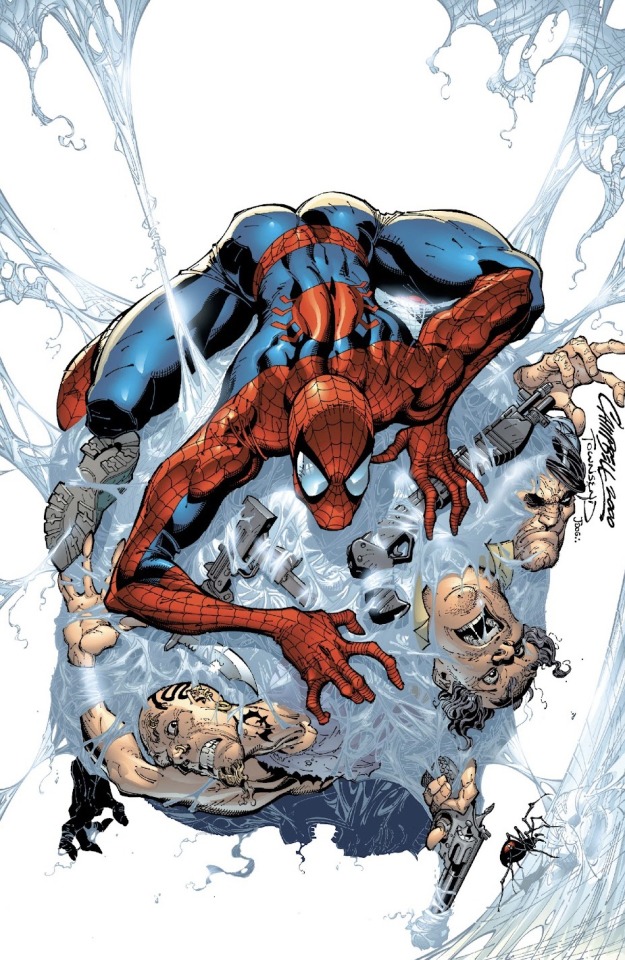
Underrated classic or drastically overrated?
Eric and our special guest - fountain of Spidey knowledge Reeds_Reads - look back at his opening arc ‘Coming Home’ in the latest OMNIVERSE BOOK CLUB episode - only in the Omniverse Comics Guide podcast!
PLAY: Spider-Man: Coming Home
Featured cover art:
AMAZING SPIDER-MAN #30 (2001) by J Scott Campbell, Tim Townsend & JDog
#spider man#j michael straczynski#j scott campbell#marvel comics#omniverse book club#omniverse comics guide#podcast
27 notes
·
View notes